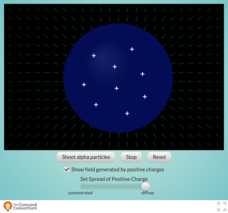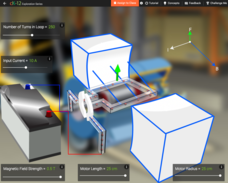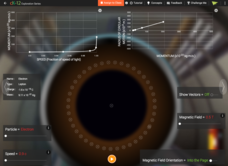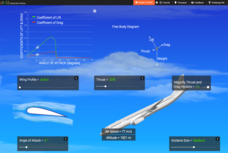Concord Consortium
Pendulum
Add some zing to your swing! Explore pendulum motion through an engaging interactive. Physical science scholars specify the pendulum's mass, rod length, and starting angle before they observe the resulting angle graph.
CK-12 Foundation
Touch Screen
Touch screens are becoming more common, but how do they work? The simulation shows the electric potential versus system charge as scholars alter three variables. The schematic of the capacitance demonstrates the set up as each variable...
Physics Classroom
Coulombs Law
How are charge, distance, and force related in electrostatics? Science scholars ponder the outcomes of changing variables using an interactive resource from the Static Electricity series. Individuals practice using Coulomb's Law as they...
Concord Consortium
Concentrating Charge and Electric Fields
How did Rutherford determine that the nucleus was the center of an atom? Take a look inside the famous Gold Foil Experiment with an interesting interactive. Learners fire a beam of alpha particles at a nucleus containing variable...
PHET
Geometric Optics
What would happen if your entire world was flipped upside down? In addition to changing the distance and size of an object, lenses flip the image upside down. The simulation allows scholars to vary the object, move the object, move the...
CK-12 Foundation
Bumper Cars
Is the transfer of energy different in bumper cars with stable versus bouncy bumpers? One of the variables explored in the simulation is bumper type; other variables are the mass and velocity of each car. This allows pupils to see the...
CK-12 Foundation
Stow Lake
Does the depth of a pond matter to the waves created when rain is falling? Many people assume the answer is no, but interestingly, it does matter. Pupils explore this concept and other variables related to wave behavior through a...
CK-12 Foundation
Bow and Arrow
Where does the energy of an arrow come from? Is it from the person, the bow, or somewhere else? A simulation allows scholars to adjust the stretch distance and the elastic constant in order to understand where the energy comes from, what...
CK-12 Foundation
Sprinter
Why do sprinters wear spiked shoes? Scholars explore various styles of shoes and how they handle forces when running. Scholars adjust variables including shoe type, horizontal force, surface type, and normal force to determine which...
CK-12 Foundation
Ramp and Piano
Can you lift a piano into a truck? Simulation allows scholars to explore the relationship between force, ramp length, and weight. Pupils control the variables of truck bed height, ramp length, weight of piano, and the number of friends...
CK-12 Foundation
Heat Engine
How can heat power an engine? Scholars observe a heat engine working and control variables to determine the most efficient setup. They change the amount of heat input as well as the stroke length. Energy efficiency numbers prove the...
CK-12 Foundation
Power Lines
How does electricity travel through power lines? The simulation demonstrates the how changes in voltage and resistance are related to the distance between power polls and the thickness of the cable. Scholars control three variables in...
CK-12 Foundation
Galvanometer
In 1820, Hans Christian Orstead discovered the link between electricity and magnetism, which allows us to measure current and voltage. The simulation allows scholars to observe the inner workings of an ammeter and voltmeter as they...
CK-12 Foundation
Electric Motor
How does a direct current run a motor? Pupils control five variables in an electric motor and observe how the force diagram changes. The force, magnetic field, and current vary based on the changes in the design of the magnet and...
CK-12 Foundation
Particle Tracks
Did you know physicists can identify new particles by observing the path they take in a particle accelerator? Scholars explore the variables that determine the direction and radius of the circular path different particles take. They...
CK-12 Foundation
Electric Ice Sheet
Tommy is trapped on an ice bridge and needs you to balance the charges so he doesn't fall into the icy water! Scholars apply Coulomb's Law, which relates to both the strength and the distance between charges. They work with these two...
CK-12 Foundation
Roller Coaster
Roller coasters rely on both kinetic and potential energy, but how much total energy does a roller coaster need? Scholars vary the mass of a coaster and the height of the initial hill. Graphs showing the types of energy and total energy...
CK-12 Foundation
Airplane
How does an airplane control its take off and descent? Scholars explore the forces acting on an airplane and control the angle of attack, wing profile, thrust, and airplane size. They learn about lift, drag, thrust, gravity, and the...
CK-12 Foundation
Newton's Apple
Scientists state that the higher something is above the earth, the greater the gravitational potential energy. Does this mean there is more gravity acting on the moon than on an apple falling from a tree? Scholars adjust the distance...
CK-12 Foundation
Cannon Simulation
Fire in the hole! Thrill your classes as they see what it's like to fire a cannon ball. Scholars practice aiming a cannon ball by altering first the firing angle, then the velocity, and finally both simultaneously. Can they discover the...
CK-12 Foundation
Oscillations Simulation
What makes a swing go back and forth like a pendulum rather than going all the way around? Scholars use the simulation to explore pendulums and how they work. They vary the weight, length of the rope, and even gravity in various trials.
Magic of Physics
Wave Machine
Three main factors determine the wave height experienced in the ocean. Scholars use a virtual simulator to alter wind speed, fetch, and duration. Each combination creates a unique wave measured in significant height.
Curated OER
Energy, Work and Power
In this energy, work and power activity, students solve 12 problems about circuits, electric motors, Ohm's Law and electric currents.
Curated OER
Peak, Average, and RMS Measurements
In this voltage worksheet, students answer ten questions about RMS amplitude, DC power sources, AC alternators and the measurements used for voltage in power lines.























